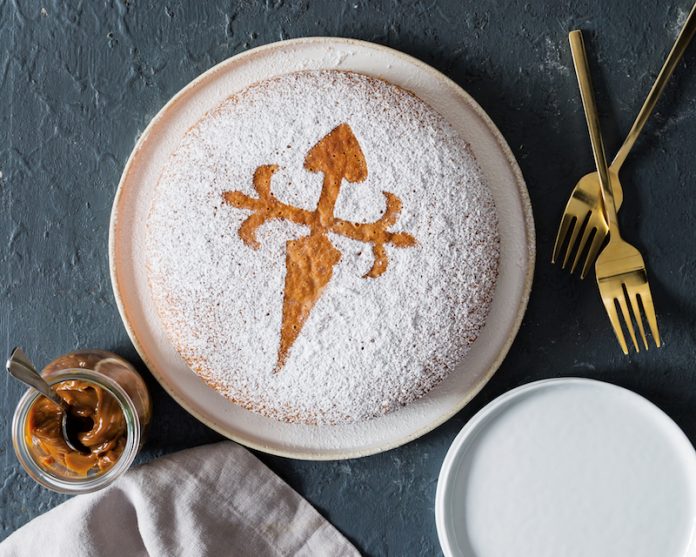
Take part in a long-standing Spanish tradition as you savor this simple one-layer cake, and discover the esteemed reason behind its iconic cross.
Leading up to July 25, legions of people embark on a spiritual journey to walk (and sometimes cycle) the Camino de Santiago (the Way of St. James). This ancient pilgrimage route, which consists of a large network of pathways across Europe, has drawn in hundreds of thousands of people in recent years. On some routes—many marked by gold scallop shells, the symbol of the pilgrim—travelers will encounter the Pyrenees mountain range, while others will be graced with trails flanked by vineyards or eucalyptus forests.
No matter which route is taken, all roads lead to Galicia, a breathtaking region tucked away in northwest Spain. What awaits them at the end of this pilgrimage, after meeting the steps of the Cathedral of Santiago de Compostela? A dense, lightly sweetened almond cake called Tarta de Santiago that people have been consuming for centuries.
Boasting a picturesque coastline and a gastronomy that rivals the best of Europe, Galicia is home to the Cathedral of Santiago de Compostela, where it is reputed that the remains of St. James (Santiago), the patron saint of Spain, rest. The cathedral represents an overwhelming mix of Romanesque, Gothic, and baroque architecture, with its crowning artistic jewel being the world-famous Portico of Glory, an elaborate gateway depicting more than 200 detailed, hand-carved biblical figures. Those hiking the Camino will ultimately arrive here, the final destination, in order to pay their respects and begin the day of feasting, delighting in Tarta de Santiago in remembrance of St. James.

While the origin of Tarta de Santiago is, like many old traditions, fairly unclear, most claim the cake was brought to Galicia by a pilgrim and subsequently consumed by those making the journey to the cathedral. Written references to this cake stretch as far back as 1577, when it was referred to as torta real, or “royal cake.” However, the first recorded recipe of tarta de almendra, or “almond cake,” didn’t appear until 1838.
Most recipes called for three simple ingredients signature to desserts in the Iberian Peninsula region: eggs, almonds, and sugar. But what it lacks in complexity, it makes up for in utility. Its hefty, crunchy crumb—due to the absence of flour or aeration in the batter—makes it a durable, on-the-go snack for hikers on the Camino de Santiago. And nearly everyone agrees its density makes it an ideal companion for a warm cup of café con leche.
While the cake itself has a minimalistic formula, its adornment, an outline of the cross of St. James, is what sets it apart. This particular cross is known as an espada, a hybrid of a sword and a cross, and can be made by gently placing either a stencil or a physical cross of St. James on the center of the cake and then dusting a generous amount of confectioners’ sugar on top.

Though it may seem unassuming, this emblem dates all the way back to the year 844, and it was used as a symbol of the Order of Santiago, a religious and military order founded in the 12th century. Nowadays, the cross of St. James exemplifies the power of Christianity, serving as a reminder of God’s protection for the people of Galicia, along with those who make the trek and who bake this iconic Galician cake.
Of the thousands who flock to Galicia each summer, not all take part in the daunting expedition on the Camino. But by baking this cross-bearing cake, they are engaging in a fundamental part of the spiritual journey. While a one-layer cake may seem much too modest to hold such paramount significance, it’s a right of passage when honoring the patron saint of Spain, with each bite connecting you to countless pilgrims who have been nourished by this very same cake. It doesn’t get much sweeter than that.
Find the recipe for the Tarta de Santiago in our July/August 2019 issue, and adorn your cake with the signature cross of St. James! We make it easy for you with a printable PDF stencil.




[…] is one of Spain’s regional treasures. This sweet has its origins in Galicia amongst the pilgrims of the Middle Ages. An almond filling atop a humble pastry base, the traditional “Torta” (or ‘Tarta’ in […]
This cake is easy and delicious. At first I was leery because there is no wheat flour, nor baking soda or baking powder. But it was light and delicious. Instead of topping it with dolce de leche, as recommended, I topped each piece with candied orange peel and zabaglione made with grand marnier and vermouth – perfect match.